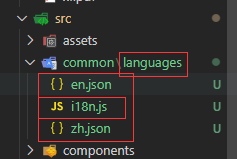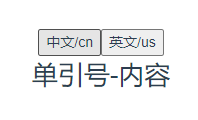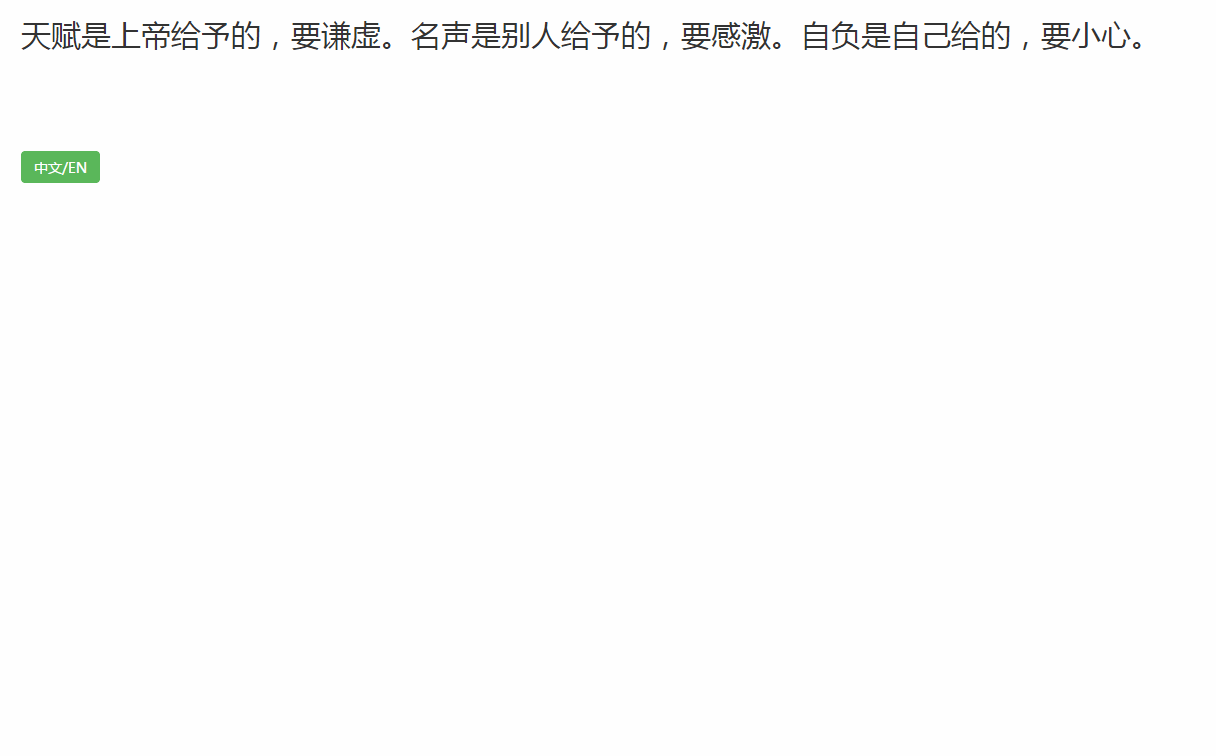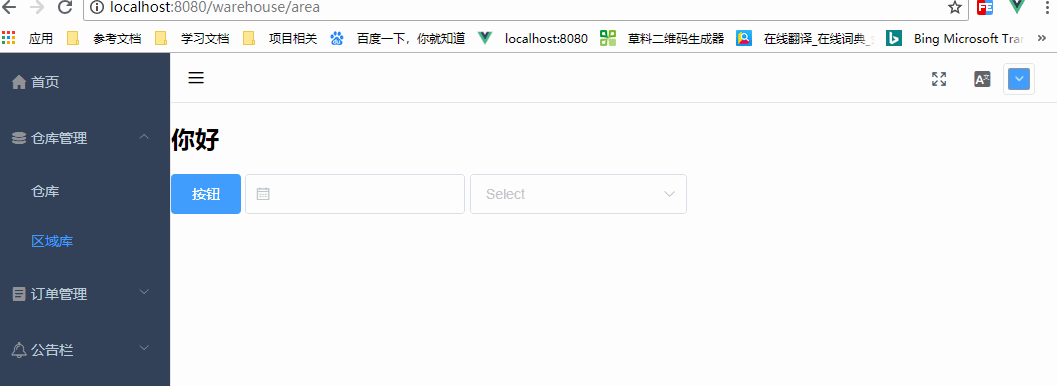使用vue-i18n切换中英文-网页语言切换案例-vue文件中或路由(Router)文件中使用
vue-i18n地址
安装
npm install vue-i18n使用
在 main.js 中引入 vue-i18n (前提是要先引入 vue)
import VueI18n from 'vue-i18n'
Vue.use(VueI18n)准备本地的翻译信息
const messages = {
zh: {
message: {
hello: '好好学习,天天向上!'
}
},
en: {
message: {
hello: 'good good study, day day up!'//study hard and make progress every day!
}
}
}创建带有选项的 VueI18n 实例
const i18n = new VueI18n({
locale: 'en', // 语言标识
messages
})把 i18n 挂载到 vue 根实例上
const app = new Vue({
router,
i18n,
...App
}).$mount('#app')HTML 模板中使用
<div id="app">
<h1 style="font-size: 16px; text-align: center;">{{ $t("message.hello") }}</h1>
</div>运行效果
![]()
刚才选定的语言标识是 “en” 英语,现在改成 “zh” 中文,并查看效果
![]()
这样就可以轻松实现国际化了,实际开发中,页面内容肯定是很多的,我们可以把对应语言的信息保存为不同的 json对象
方法一(♥):

i18n.js
// 配置
import Vue from 'vue'
import VueI18n from 'vue-i18n';
Vue.use(VueI18n) // 通过插件的形式挂载//中 cn 英 us
export const i18n = new VueI18n({
locale: localStorage.getItem('language') || 'cn',
//this.$i18n.locale // 通过切换locale的值来实现语言切换
messages: {
'cn': require('./zh.json'), // 中文语言包
'us': require('./en.json'), // 英文语言包
}
});
// console.log(i18n, 'i18n')
// 重新封装方法
export function $t(args) {
return i18n.tc.call(i18n, args);
}//zh.json
{
"home":{
"neirong":"内容",
"dyh":"单引号"
}
}
//en.json
{
"home":{
"neirong":"content",
"dyh":"Jackie"
}
}main.js
// 引入语言转换
// import VueI18n from 'vue-i18n';
// Vue.use(VueI18n);
import { i18n } from './common/languages/i18n.js'
new Vue({
i18n,
render: h => h(App)
}).$mount("#app");使用
<template>
<div class="wrap">
<button @click="btn('cn')">中文/cn</button>
<button @click="btn('us')">英文/us</button>
<p class="pm">{{$t("home.dyh")}}-{{$t("home.neirong")}}</p>
</div>
</template>
<script>
export default {
mounted(){
console.log(this.$t)
},
methods: {
btn(t) {
console.log("获取",t);
localStorage.setItem("language", t);
// 刷新当前页面
location.reload();
this.$router.go(0);
},
},
};
</script>
<style lang="less" scoped>
.pm{
font-size: 26px;
}
</style>

拓展-路由文件-store-confirm-i18n
集成的vue-router,在router文件夹里的index.js中是用不了this.$t('xxxxx')这样的翻译和this.$confirm()这样的组件的
1.路由中使用store的方法:
router.app.$store
2.路由中使用elment-ui组件的方法:
Vue.prototype.$confirm()
3.路由中使用i18n国际化翻译的方法
//import i18n from "../i18n";
import { i18n,$t } from '@/common/languages/i18n.js'
i18n.t('CommonBtn.Confirm')
或
$t('CommonBtn.Confirm')有时候在data中使用
语言不能及时刷新,可以使用监听重新赋值实现,或者写在计算属性中返回使用
<template>
<div>
<div class="solutions">{{ solutions }}</div>
</div>
</template>
<script>
export default {
watch: {
'$store.state.lang'(language) {
this.init()
}
},
data() {
return {
solutions : this.$t('solutions')
}
},
created() {
this.init()
},
methods: {
init(){
this.solutions = this.$t('solutions')
}
},
}
</script>方法二:
const i18n = new VueI18n({
locale: 'en', // 语言标识
messages: {
'zh': require('./common/lang/zh'),
'en': require('./common/lang/en')
}
})//zh.js
// 注意:一定是 exports,不是 export,否则会报错,报错信息是下列的中的内容不是 string
module.exports = {
message: {
title: '运动品牌'
},
placeholder: {
enter: '请输入您喜欢的品牌'
},
brands: {
nb: '新百伦',
ln: '李宁'
}
}//en.js
module.exports = {
message: {
title: 'Sport Brands'
},
placeholder: {
enter: 'Please type in your favorite brand'
},
brands: {
nb: 'New Banlance',
ln: 'LI Ning'
}
}在HTML 模板中使用,要特别注意在 js 中的国际化写法
// HTML
<div id="app">
<div style="margin: 20px;">
<h1>{{$t("message.title")}}</h1>
<input style="width: 300px;" class="form-control" :placeholder="$t('placeholder.enter')">
<ul>
<li v-for="brand in brands">{{brand}}</li>
</ul>
</div>
</div>
// JS
data () {
return {
brands: [this.$t('brands.nike'), this.$t('brands.adi'), this.$t('brands.nb'), this.$t('brands.ln')]
}
},
在上面的操作中,我们都是通过手动修改 locale 的属性值来切换语言,实际上,更希望浏览器自动识别,这里可以借助于 cookie
新建一个 cookie.js 文件,用于读取cookie
function getCookie(name,defaultValue) {
var arr, reg = new RegExp("(^| )" + name + "=([^;]*)(;|$)");
if (arr = document.cookie.match(reg))
return unescape(arr[2]);
else
return defaultValue;
}
export {
getCookie
}在 main.js 中引入这个js,并通过 PLAY_LANG 属性来获取浏览器的语言
const i18n = new VueI18n({
locale: getCookie('PLAY_LANG','zh'), // 语言标识
messages: {
'zh': require('./common/lang/zh'),
'en': require('./common/lang/en')
}
})注意
两个极易出错的地方
将 $t() 写成了 $()

json 中在同一个对象里有同名属性

vue-i18n 提供了一个全局配置参数叫 “locale”,通过改变 locale 的值可以实现不同语种的切换

案例
借用了 Element UI 的弹窗样式,上面的步骤不再赘述,直接上核心代码
// template
<h2>{{$t('test')}}</h2>
<button type="button" class="btn btn-success" @click="changeLocale">中文/EN</button>
// js方法
changeLocale () {
this.$confirm(this.$t('layer.toggle'), this.$t('layer.tips'), {
confirmButtonText: this.$t('button.ok'),
cancelButtonText: this.$t('button.cancel'),
type: 'warning'
}).then(() => {
let locale = this.$i18n.locale
locale === 'zh' ? this.$i18n.locale = 'en' : this.$i18n.locale = 'zh'
}).catch(() => {
this.$message({
type: 'info',
})
})
},
在配合 Element-UI 一起使用时,会有2个问题:
(1)、页面刷新后,通过按钮切换的语言还原成了最初的语言,无法保存
(2)、框架内部自带的提示文字无法更改,比如像时间选择框内部中的提示文字
关于第一个问题,可以在初始化VueI18n实例时,通过 localStorage 来为 locale 对象赋值
const i18n = new VueI18n({
locale: localStorage.getItem('locale') || 'zh',
messages
})在切换语言的时候可以缓存不同的语言选项,并且可以长期保存,不会因为刷新网页而改变locale 的属性值
<div class="lang">
<el-dropdown>
<i class="iconfont icon-language4"></i>
<el-dropdown-menu slot="dropdown">
<el-dropdown-item @click.native="toggleLang('zh')" :disabled="$i18n.locale == 'zh'">中文</el-dropdown-item>
<el-dropdown-item @click.native="toggleLang('en')" :disabled="$i18n.locale == 'en'">English</el-dropdown-item>
</el-dropdown-menu>
</el-dropdown>
</div>toggleLang(lang) {
if(lang == 'zh'){
localStorage.setItem('locale', 'zh')
this.$i18n.locale = localStorage.getItem('locale')
this.$message({
message: '切换为中文!',
type: 'success'
})
} else if (lang == 'en') {
localStorage.setItem('locale', 'en')
this.$i18n.locale = localStorage.getItem('locale')
this.$message({
message: 'Switch to English!',
type: 'success'
})
}关于第二个问题,更改Element 组件内部语言,这里还涉及到 手动处理 vue-i18n@6.x 兼容性问题。官网已经做了详细介绍,这里依葫芦画瓢跟着实现一下

//i18n.js
import Vue from 'vue'
import VueI18n from 'vue-i18n'
import locale from 'element-ui/lib/locale';
import zh from './langs/zh'
import en from './langs/en'
import enLocale from 'element-ui/lib/locale/lang/en'
import zhLocale from 'element-ui/lib/locale/lang/zh-CN'
Vue.use(VueI18n)
const messages = {
en: Object.assign(en, enLocale),
zh: Object.assign(zh, zhLocale)
}
console.log(messages.zh)
const i18n = new VueI18n({
locale: localStorage.getItem('locale') || 'zh',
messages
})
locale.i18n((key, value) => i18n.t(key, value)) //为了实现element插件的多语言切换
export default i18n按照如上把国际化文件都整合到一起,避免main.js 中大段引入相关代码。main.js 中与 i18n 相关的就只剩两行代码
import i18n from './i18n/i18n' // 1行
window.app = new Vue({
el: '#app',
router,
store,
i18n, // 2行
components: { App },
template: '<App/>'
})效果

本文来自博客园,作者:JackieDYH,转载请注明原文链接:https://www.cnblogs.com/JackieDYH/p/17634310.html



 浙公网安备 33010602011771号
浙公网安备 33010602011771号